Rila Monastery
By Mel
What is Rila Monastery?
Perched in the Rila mountains at 1,147 m (3763 ft) in elevation lies the largest and most famous Eastern Orthodox monastery in Bulgaria: Rila Monastery.
Disclosure: This article contains affiliate links. Making a purchase through an affiliate link will mean a small commission for this website. This will not affect your price.
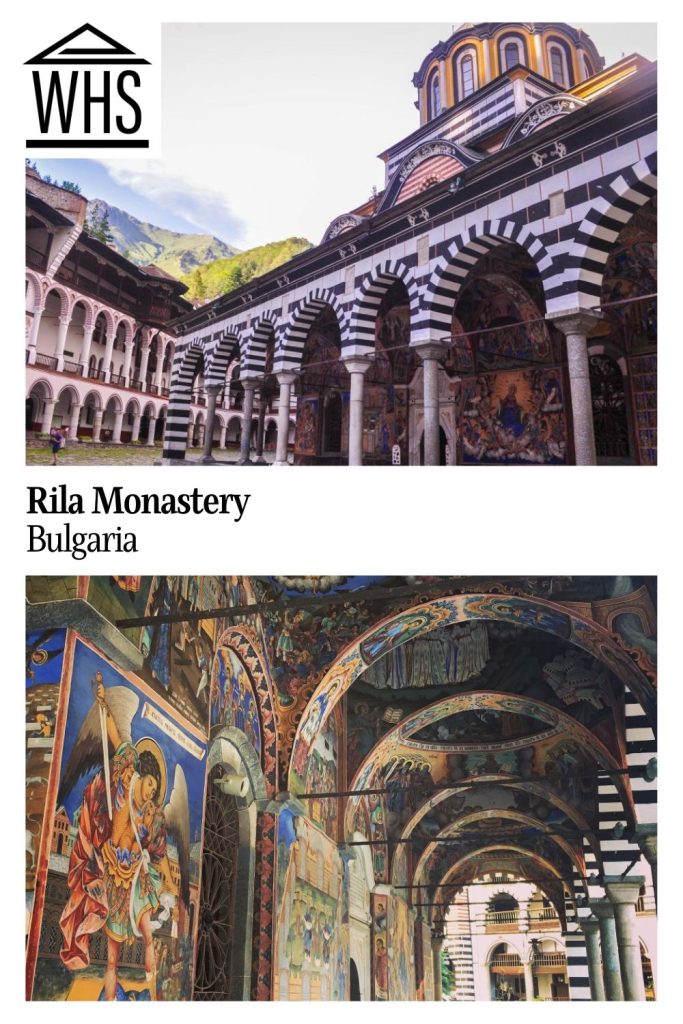
The monastery was founded in the 10th century by St John of Rila, a hermit canonized by the Orthodox Church. Through the centuries, the site played a key role in the spiritual and social life of Bulgaria. After its destruction by a fire in the 19th century, the complex took its modern form with the main church, a residential part and the monastery museum. The architecture is a prime example of the Bulgarian Renaissance (18th–19th centuries). The site has also been a shelter for persecuted revolutionaries as well as an educational centre.
Why is Rila Monastery a UNESCO World Heritage site?
Rila Monastery became a UNESCO World Heritage site in 1983 for its spiritual and artistic influence over the Eastern Orthodox world during its 1000-year lifespan. The complex was important in the Middle Ages but also under Ottoman rule, when, according to UNESCO, it “influenced the development of the culture and the arts of all Christian nations.”
During the Bulgarian Renaissance, the monastery played a key part in restoring nationalism in the country. Its reconstruction in the 19th century is an architectural gem and the frescoes highlight the craftsmanship of the country and the Balkans in general.
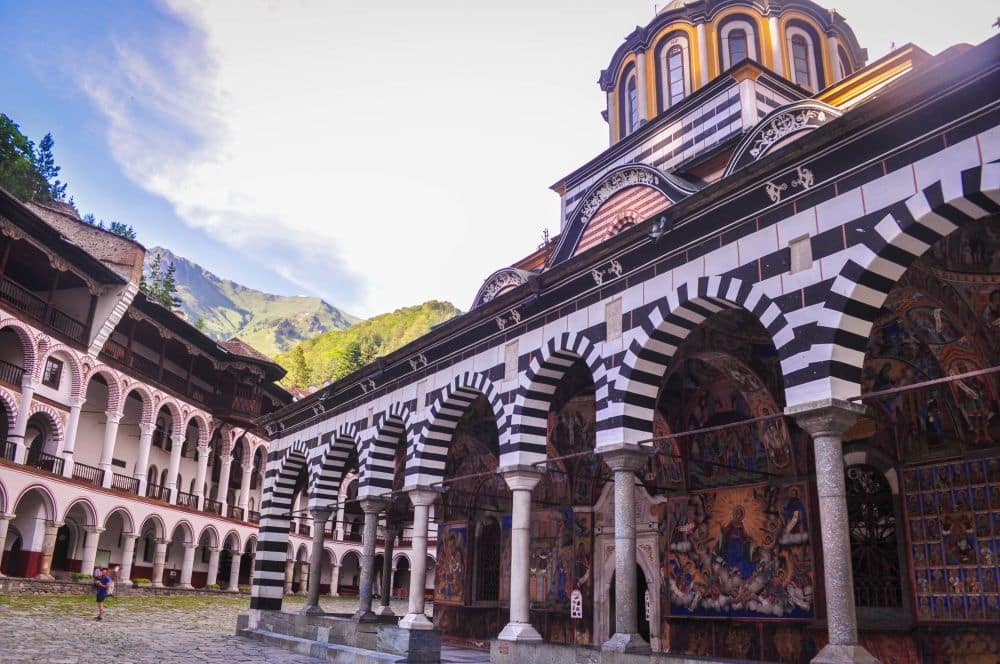
What can you expect on a visit to Rila Monastery?
Rila Monastery is in a serene setting nestled among the mountains. Not only are its natural surroundings astonishing but the architecture and the craftsmanship of the monastery itself is a delight for the eyes with the bright yellow domes and archways striped in black, red and white.
The monastery is divided into several areas: the main church “The Nativity of the Virgin”, Hrelio’s tower, the medieval church of Hrelio (XIV-XIX), the monastic apartments and the monastery museum.
Main church: The main church is the pillar of the complex. The inside of the church is ornate with jaw-dropping frescoes depicting the apocalyptic dance of the Day of Judgement, the genesis of Adam and Eve and the baptism of Jesus Christ. The frescoes are masterworks of the renowned brother muralists Dimitar and Zahari Zograf.
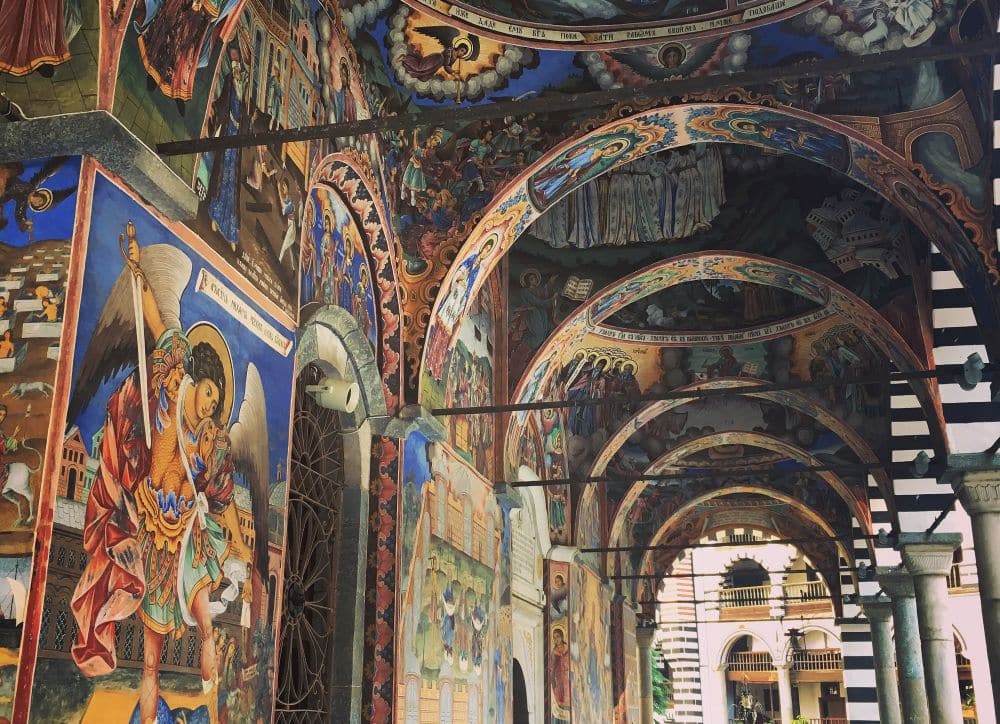
Residence: The residential part of the complex consists of 300 chambers, four chapels, an abbot’s room, a kitchen, a library housing 250 manuscripts and 9,000 old printed books, and a donor’s room.
Ethnographic Museum: This museum safeguards the famous Rafail’s Cross. This work of art depicts 104 religious scenes and 650 miniature figures and took 12 years to create. The museum also holds more than 35,000 cultural items.
Ecclesiastical Museum: The Ecclesiastical Museum holds the history of this place of worship. It highlights the evolution of the monastery but also the role it holds culturally and religiously in making Bulgaria the nation that it is today.
Hrelio Tower: The tower dates back to the 14th century and was used for defence. From the tower, you will have a complete overview of the site and its surroundings.
Is this monastery worth visiting?
The Rila Monastery is simply beautiful. Even for non-religious travelers, a trip to this UNESCO site is a must-do while visiting Bulgaria. Thankfully, Bulgaria is not yet plagued by mass tourism and your visit to the site can be pleasant without too many crowds.
You don’t need to be an art history connoisseur or a history aficionado to enjoy your visit to the monastery. Anyone can admire its setting, the architecture and its history.
If you wish to visit the complex in a superficial way, you can spend just one hour. However, if you wish to visit the museums and admire all the religious relics, you could spend half a day or several days. It all depends on how much you want to learn from this place of worship.
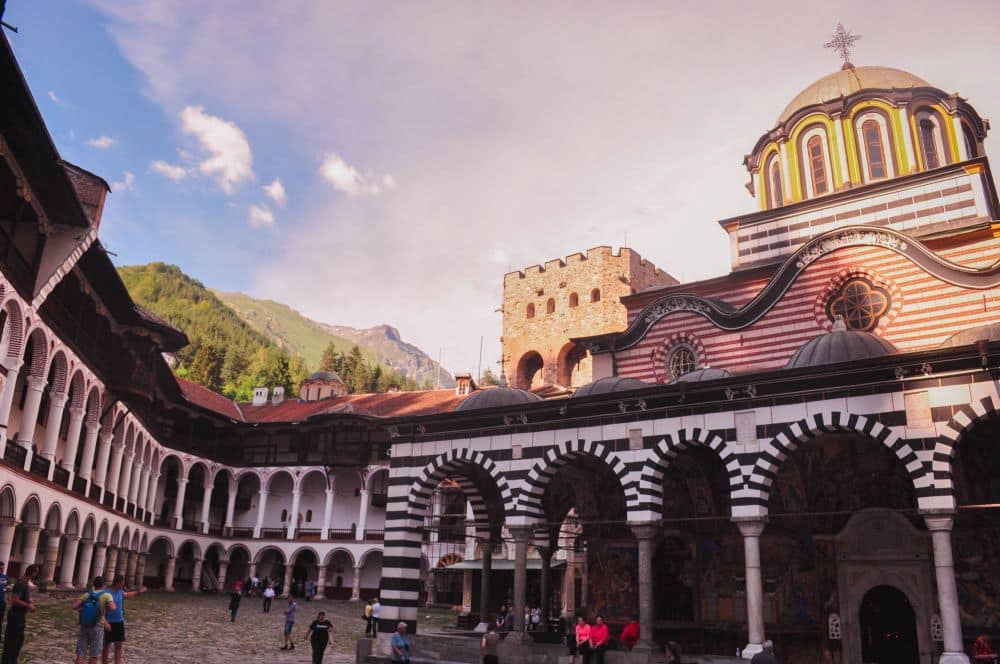
Tips for visiting Rila Monastery
Dress code: The complex is a place of worship and visitors need to dress accordingly and follow certain rules. Shorts, short skirts, and sleeveless shirts are not allowed. Women should carry a scarf. Men are requested to remove hats.
Busiest times: Summertime, weekends, public holidays and during religious holidays are when the monastery is busiest.
Smoking is not allowed on the premises nor is taking photos inside the church or the museums. Inside the church, you are required to stay silent.
The monastery is located in the mountains and it is recommended to bring a sweater even in summer as the mountain breeze can be chilly. Also, wear comfortable shoes if you wish to do a hike in the nearby trails and attractions. Please note that if you are visiting in winter, the roads might be closed because of the snow.
The monastery is known for its monastic donuts (mekitsa): fried donuts with powdered sugar or jam.
The complex offers accommodations if visitors wish to spend the night. Otherwise there are plenty of other accommodations in the vicinity.
If you’re getting to the monastery on your own but still want to take a guided tour of the complex, try this walking tour.
Entry to the complex is free but if you wish to visit the museums and buildings like the tower or the monastery farm, there are separate entry fees.
The monastery offers guided tours in English and Bulgarian. Make a reservation prior to your visit.
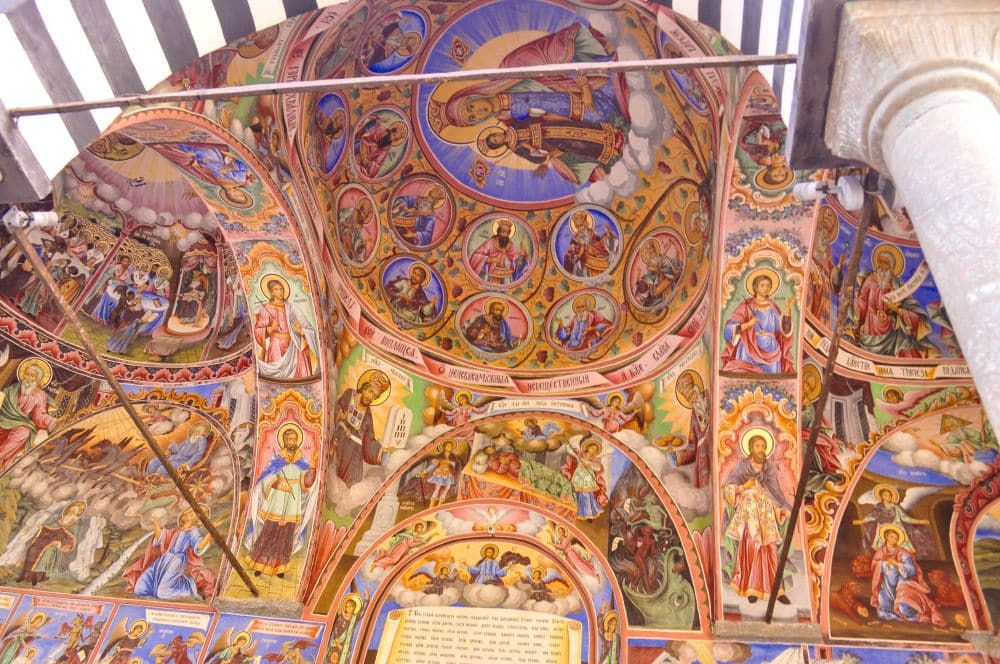
What to See Near Rila Monastery
The monastery is in a nature park but it also has other sightseeing options. These are most accessible if you are renting a car.
- St Ivan’s Cave is the original base of Saint Ivan Rilski who created the monastery. Here you will see the cave where the hermit lived for many years and the small chapel. The cave is only 4km (2.5mi) away from the monastery.
- Rila Seven Lakes is the best nearby attraction but also a must on your Bulgarian road trip. The pristine waters from the eternal snow in the mountains are a must-see. The lakes are located on the highest mountain in the Balkans. To access the lakes, you will need to hike and take a chairlift. Give this excursion at least half a day in the region. Many tours combine visiting Rila Monastery with a trip to the Seven Lakes.
- Stob Pyramids are located around 40 minutes from Rila. You will be able to admire the stone formations that look like pyramids. This is a medium-level hike.
- Bansko, a mountain resort town, is the biggest ski resort in Bulgaria.
- Dragalevski Monastery is a great destination if visiting one monastery is not enough. This Bulgarian Orthodox monastery dates to the 14th century.
- Boyana Church can be another stop in your day. This is another of Bulgaria’s UNESCO World Heritage sites and dates back to the 11th century. It hosts important medieval works of art. The church is a short 25 minutes from Sofia. Many tours combine a visit to Rila with a visit to Boyana Church.
Where is Rila Monastery?
The address is 2643 Рилски манастир, Bulgaria and is located in the Nature Park Rila Monastery.
By car: The drive from Sofia to the monastery is a 1h40min drive. You take the Sofia-Kulata highway and exit the road in Kocherinovo village. It is 30 km (19 mi) to the monastery from there. There is a designated parking area to leave the car, where the parking costs 5 leva for the day and is cash only.
By public transit: There are 2 options, the train and the bus, all from the capital Sofia.
- The train departs from Sofia Central Train Station to Dupnitsa. Then from Dupnitsa take the bus directly to Rila Monastery. There are 2 bus departures, one early in the morning at 6:40 am and then the second early in the afternoon at 2:15.
- The bus departs from Sofia at the bus station “Ovcha Kupel” and it goes directly to Rila Monastery every day at 10:20 am. The bus from Rila Monastery to Sofia is at 3:00 pm. The cost of this bus is 11 Leva.
By tours: The monastery is one of the tourist highlights of Bulgaria and several tour operator companies will have organized trips to the site. The prices depend on the packages you take. Click on the images below to see some options:
By shuttle: There are daily shuttle services departing from St. Alexander Nevski Cathedral in Sofia.
For more information about Rila Monastery, its opening hours and admission fees, see its official website.
Have you been to Rila Monastery? If so, do you have any additional information or advice about this UNESCO World Heritage site? Please add your comments below!

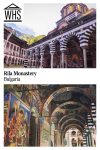
Rila Monastery is a true gem nestled in the heart of Bulgaria’s majestic mountains, its vibrant colors and serene atmosphere offering a glimpse into centuries of rich history and spiritual devotion.